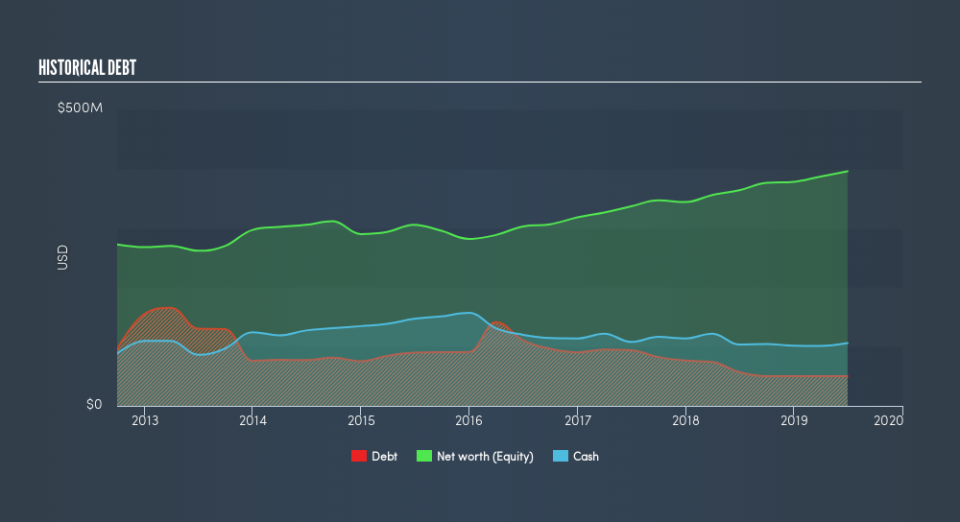CTS (NYSE:CTS) Could Easily Take On More Debt

David Iben put it well when he said, 'Volatility is not a risk we care about. What we care about is avoiding the permanent loss of capital.' When we think about how risky a company is, we always like to look at its use of debt, since debt overload can lead to ruin. Importantly, CTS Corporation (NYSE:CTS) does carry debt. But is this debt a concern to shareholders?
When Is Debt Dangerous?
Generally speaking, debt only becomes a real problem when a company can't easily pay it off, either by raising capital or with its own cash flow. In the worst case scenario, a company can go bankrupt if it cannot pay its creditors. However, a more frequent (but still costly) occurrence is where a company must issue shares at bargain-basement prices, permanently diluting shareholders, just to shore up its balance sheet. Of course, the upside of debt is that it often represents cheap capital, especially when it replaces dilution in a company with the ability to reinvest at high rates of return. The first thing to do when considering how much debt a business uses is to look at its cash and debt together.
Check out our latest analysis for CTS
What Is CTS's Debt?
As you can see below, CTS had US$50.0m of debt at June 2019, down from US$57.0m a year prior. However, its balance sheet shows it holds US$105.8m in cash, so it actually has US$55.8m net cash.
A Look At CTS's Liabilities
Zooming in on the latest balance sheet data, we can see that CTS had liabilities of US$96.3m due within 12 months and liabilities of US$88.8m due beyond that. Offsetting these obligations, it had cash of US$105.8m as well as receivables valued at US$84.9m due within 12 months. So it can boast US$5.60m more liquid assets than total liabilities.
Having regard to CTS's size, it seems that its liquid assets are well balanced with its total liabilities. So it's very unlikely that the US$918.6m company is short on cash, but still worth keeping an eye on the balance sheet. Succinctly put, CTS boasts net cash, so it's fair to say it does not have a heavy debt load!
In addition to that, we're happy to report that CTS has boosted its EBIT by 50%, thus reducing the spectre of future debt repayments. When analysing debt levels, the balance sheet is the obvious place to start. But it is future earnings, more than anything, that will determine CTS's ability to maintain a healthy balance sheet going forward. So if you're focused on the future you can check out this free report showing analyst profit forecasts.
But our final consideration is also important, because a company cannot pay debt with paper profits; it needs cold hard cash. While CTS has net cash on its balance sheet, it's still worth taking a look at its ability to convert earnings before interest and tax (EBIT) to free cash flow, to help us understand how quickly it is building (or eroding) that cash balance. Over the most recent three years, CTS recorded free cash flow worth 59% of its EBIT, which is around normal, given free cash flow excludes interest and tax. This free cash flow puts the company in a good position to pay down debt, when appropriate.
Summing up
While we empathize with investors who find debt concerning, you should keep in mind that CTS has net cash of US$56m, as well as more liquid assets than liabilities. And we liked the look of last year's 50% year-on-year EBIT growth. So we don't think CTS's use of debt is risky. Over time, share prices tend to follow earnings per share, so if you're interested in CTS, you may well want to click here to check an interactive graph of its earnings per share history.
When all is said and done, sometimes its easier to focus on companies that don't even need debt. Readers can access a list of growth stocks with zero net debt 100% free, right now.
We aim to bring you long-term focused research analysis driven by fundamental data. Note that our analysis may not factor in the latest price-sensitive company announcements or qualitative material.
If you spot an error that warrants correction, please contact the editor at editorial-team@simplywallst.com. This article by Simply Wall St is general in nature. It does not constitute a recommendation to buy or sell any stock, and does not take account of your objectives, or your financial situation. Simply Wall St has no position in the stocks mentioned. Thank you for reading.

